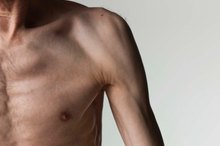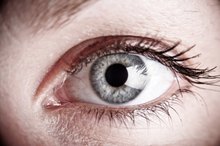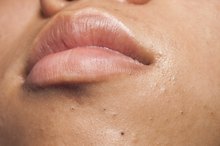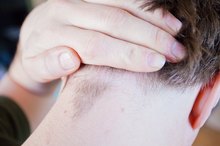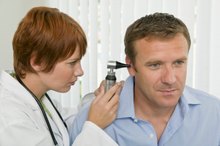What does fact checked mean?
At Healthfully, we strive to deliver objective content that is accurate and up-to-date. Our team periodically reviews articles in order to ensure content quality. The sources cited below consist of evidence from peer-reviewed journals, prominent medical organizations, academic associations, and government data.
The information contained on this site is for informational purposes only, and should not be used as a substitute for the advice of a professional health care provider. Please check with the appropriate physician regarding health questions and concerns. Although we strive to deliver accurate and up-to-date information, no guarantee to that effect is made.
Bumps on the Top of My Ears
Ears are generally very tender and sensitive. If you develop bumps on the top of your ears, it may be uncomfortable and painful. It may make tasks, such as talking on a telephone, more difficult to perform. Depending upon the cause of the bumps, your hair may aggravate them.
If you are experiencing serious medical symptoms, seek emergency treatment immediately.
Size
The bumps on the top of your ears can vary in size. The bumps may be as small as a tiny whitehead or as larger pea-sized bumps. The diameter can also vary, ranging from the size of the tip of a ballpoint pen or as wide as the tip of your finger. Size will greatly depend upon the cause of the bump or bumps.
- The bumps on the top of your ears can vary in size.
- The bumps may be as small as a tiny whitehead or as larger pea-sized bumps.
Features
Little Bumps on the Ears
Learn More
The bumps may appear small and hard or large and tender. They can resemble acne, blisters or larger sores. The skin on and around the bumps may be rough, flaky or smooth. The bumps may or may not have texture, depending upon the cause. If the bumps are infected, pus may ooze from the site. The pus will harden and cause crusting. If you have long hair, your hair may stick to the pus as it dries, making it very painful when you sweep your hair back, as it rips away from the infection.
- The bumps may appear small and hard or large and tender.
- The skin on and around the bumps may be rough, flaky or smooth.
Causes
Acne can cause these bumps. This can happen when a whitehead or pimple forms on the top of your ear. Gel, hairspray and mousse can cause acne to develop when the sticky substances dry on your skin and clog pores. Rosacea can also appear as acne on your ears, according to the American Academy of Dermatology. Skin cancer can form on the top of your ears, creating a single bump or a cluster of bumps, according to DermNet NZ 2. You may have developed psoriasis on the tops of your ears or keloid scars from an injury or ear piercing.
- Acne can cause these bumps.
- This can happen when a whitehead or pimple forms on the top of your ear.
Prevention/Solution
White Bumps on the Top of My Ears
Learn More
If acne forms on the top of your ears, consider styling your hair differently or using oil-free hair products. Oil-free products will not cause your pores to clog. If the bumps are caused by rosacea, your health care provider may prescribe a topical antibiotic cream or lotion to help treat your condition. If you have skin cancer, treatment will vary depending upon the stage of skin cancer. Psoriasis is typically treated by using a moisturizer and switching to mild soap and shampoo; mild detergents tend to be less irritating to your skin. If the bumps are keloids from ear piercings or an injury, treatment options consist of having injections, wearing silicone sheets over the area or undergoing laser surgery.
- If acne forms on the top of your ears, consider styling your hair differently or using oil-free hair products.
- If the bumps are caused by rosacea, your health care provider may prescribe a topical antibiotic cream or lotion to help treat your condition.
Considerations
To prevent skin cancer, wear sunscreen while outdoors and reapply often if you’re outside for prolonged periods. Wearing protective clothing, such as a hat, can help block the sun from reaching your skin. If you’re thinking of getting your ears pierced, consult with your physician to see if you’re a likely candidate to develop a keloid. Teenagers, pregnant women and those who have a family history of keloids are more likely to develop keloids, according to FamilyDoctor.org. Always consult your physician if the bumps on your ears don't go away with simple home treatments or if you are concerned about them at all.
- To prevent skin cancer, wear sunscreen while outdoors and reapply often if you’re outside for prolonged periods.
- Always consult your physician if the bumps on your ears don't go away with simple home treatments or if you are concerned about them at all.
Related Articles
References
- DermNet NZ: Squamous Cell Carcinoma
- DermNet NZ: Guttate Psoriasis
- Avhad G, Ghate S, Dhurat R. Milia en plaque. Indian Dermatol Online J. 2014;5(4):550-1. doi:10.4103/2229-5178.142573
- Gold MH, Baldwin H, Lin T. Management of comedonal acne vulgaris with fixed-combination topical therapy. J Cosmet Dermatol. 2018;17(2):227-231. doi:10.1111/jocd.12497
- Tagliolatto S, Santos neto Ode O, Alchorne MM, Enokihara MY. Sebaceous hyperplasia: systemic treatment with isotretinoin. An Bras Dermatol. 2015;90(2):211-5. doi:10.1590/abd1806-4841.20153192
- Zuber TJ. Minimal excision technique for epidermoid (sebaceous) cysts. Am Fam Physician. 2002;65(7):1409-12, 1417-8, 1420.
- Wollina U. Seborrheic Keratoses - The Most Common Benign Skin Tumor of Humans. Clinical presentation and an update on pathogenesis and treatment options. Open Access Maced J Med Sci. 2018;6(11):2270-2275. doi:10.3889/oamjms.2018.460
- Dodds A, Chia A, Shumack S. Actinic keratosis: rationale and management. Dermatol Ther (Heidelb). 2014;4(1):11-31. doi:10.1007/s13555-014-0049-y
- Lanoue J, Goldenberg G. Basal Cell Carcinoma: A Comprehensive Review of Existing and Emerging Nonsurgical Therapies. J Clin Aesthet Dermatol. 2016;9(5):26-36.
- Nair PA, Singhal R. Xanthelasma palpebrarum - a brief review. Clin Cosmet Investig Dermatol. 2018;11:1-5. doi:10.2147/CCID.S130116
- "Actinic keratosis." MedlinePlus Medical Encyclopedia. U.S. National Library of Medicine, National Institutes of Health, 07 May 2017. Web. https://medlineplus.gov/ency/article/000827.htm
- "Milia." MedlinePlus Medical Encyclopedia. U.S National Library of Medicine. National Institutes of Health, 21 Apr 2015. Web. https://medlineplus.gov/ency/article/001367.htm
- "Seborrheic Keratoses." AAD.org. American Academy of Dermatology. Web.https://www.aad.org/public/diseases/bumps-and-growths/seborrheic-keratoses
- Zaenglein AL, Pathy AL, Schlosser BJ, Alikhan A, Baldwin HE, et. al. "Guidelines of Care for the Management of Acne Vulgaris." Journal of the American Academy of Dermatology. 2016; 74 (5):945-73.
Writer Bio
Kristin Davis has been writing since 2004, specializing in the health and fitness fields. She has written for online and print publications including Fitness Monthly and Creative Circle. Davis has certification through the International Fitness Professionals Association as a personal trainer.



